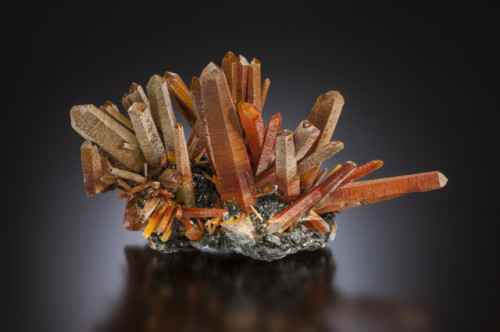Quartz With Hydrocarbon Inclusions Kharan, Baluchistan, Pakistan


Quartz With Hydrocarbon Inclusions Kharan, Baluchistan, Pakistan
More Posts from Tres-4b-blog and Others

Like a paintbrush caressing the rings of Saturn, wee moon Daphnis has just enough gravity to make a ripple. (at NASA’s Cassini Mission to Saturn)

Mission Control. It appears to be the profile & vest of Flight Director Gene Kranz at the helm. Mission Control is located at the Johnson Space Center, established in 1961 & renamed after President Lyndon Johnson in 1973. The JSC covers 1620 acres & 100 buildings. Flights from Project Gemini (following Gemini 3), Apollo, Skylab, Apollo–Soyuz & the Space Shuttle were monitored from here.
This is Earth, our amazing home. The only planet in the solar system with the ability to harbor life (that we know of).

This is the distance between our awesome planet and the moon.

Doesn’t look that far does it? How about if I told you that you could fit EVERY planet in our solar system neatly in that distance.

Speaking of the other planets in our solar system, this is them & this is where our amazing planet resides.

The moon’s our cute little companion. This is the United States compared to it.

The planets in the solar system are so cool. This is what North America looks like in comparison to Jupiter.

Speaking of Jupiter and the moon, this is what it would look like if Jupiter was in the place of the moon. (The white dot is our moon).

Earth compared to Saturn (well 6 Earths…)

Ever wonder about what Earth would look like if it had rings like Saturn? Well wonder no more..

Amazing right? Want to see something cooler? Here is the Earth compared to our Sun.

Here’s what we look like from the moon

And from Mars

From Saturn

From Neptune…

Here is what the Sun looks like from Mars

Remember what Carl Sagan said? There are more stars in space than grains of sand on every beach in the Earth.

That’s a lot right? That only means there are stars way larger than our Sun..like this one for example:

And there are stars bigger than that….

Stars are huge, but the galaxy is even bigger. If you shrunk the Sun down to the size of a white blood cell, the Milky Way Galaxy would be the size of the United States.

This is where the Earth is in our huge galaxy

You know all the stars we see in the sky? These are the ones we only ever see (this isn’t our galaxy but its very similar)

The Milky Way is so big that the last time the Earth was in this exact position in the galaxy, the dinosaurs were here

Even though our galaxy is huge, there are galaxies that are even bigger…

This picture from Hubble shows thousands of thousands of thousands of galaxies that each have their own stars with their own planets…

Here is one of the galaxies in that picture. It is 10 BILLION light years away. When we look at it, we are looking 10 BILLION YEARS BACK IN TIME

And just to keep this in mind, this is a very small portion of the sky that was believed to be empty…

Everything is relative.
Next time you’re stressed out or worried about something, stop and take a step back. Look up at the sky and think about all of the things that are out there. All the stars being born, the stars dying, galaxies colliding.
We live in such an amazing universe, and we are only an extremely tiny part of it.
Credit- pictures from: Buzzfeed on Facebook










SpaceTime 20190503 Series 22 Episode 34 is now out
SpaceTime covers the latest news in astronomy & space sciences.
The show is available as a free twice weekly podcast through Apple Podcasts (itunes), Stitcher, Google Podcast, Pocketcasts, SoundCloud, Bitez.com, YouTube, Audio Boom, your favourite podcast download provider, and from www.spacetimewithstuartgary.com
SpaceTime is also broadcast coast to coast across the United States on Science360 Radio by the National Science Foundation in Washington D.C. and around the world on Tune-In Radio.
SpaceTime daily news blog: http://spacetimewithstuartgary.tumblr.com/ SpaceTime facebook: www.facebook.com/spacetimewithstuartgary SpaceTime Instagram @spacetimewithstuartgary SpaceTime twitter feed @stuartgary SpaceTime YouTube: https://www.youtube.com/c/SpaceTimewithStuartGary
Today’s stories…
First results from ExoMars Trace Gas Orbiter During its first year in orbit the ExoMars Trace Gas Orbiter has made some surprizing discoveries about the impact of the recent global Martian dust storm and an apparent lack of methane in the red planet’s atmosphere.
Dragon spacecraft destroyed in dramatic explosion The first crew Dragon two capsule which successfully flew to the International Space Station in March has been destroyed in a major explosion at the Cape Canaveral air force station in Florida.
Stratolaunch test flight Stratolaunch has successfully undertaken the first test flight of the company’s behemoth twin fuselage six engine jetliner designed to launch satellites into space.
May Skywatch We tour the night skies of May which play host to the annual Eta-Aquarids meteor shower generated by Halley’s Comet.
Last Wednesday’s show…
New model for Nova explosions Scientists will need to go back to the drawing board to come up with new ways in which powerful explosions – known as novae – can occur on the surfaces of white dwarf stars.
Explaining super-luminous novae Astronomers have discovered that shockwaves generated during nova explosions can dramatically amplify their power and brightness.
NASA’s InSight Detects First Likely ‘Quake’ on Mars NASA’s Mars InSight lander has measured and recorded for the first time ever a likely “marsquake.”
New physics needed to explain differences in the Hubble Constant New observations are showing that differences in how fast the universe is expanding now compared to how fast it was expanding billions of years ago are no statistical accident.
The Science Report Climate change is now threatening the world’s doomsday vault. The world’s second largest colony of emperor penguins almost wiped out. Extreme ocean winds and wave heights are increasing around the globe. A small bone behind the knee, which was once rare in humans is becoming more common. Palaeontologists have unearthed a new species of hadrosaur dinosaur in Mongolia. History revisionists spewing lies and cherry-picked half-truths for racist and political propaganda
SpaceTime Background SpaceTime is Australia’s most respected astronomy and space science news program. The show reports on the latest stories and discoveries making news in astronomy, astrophysics, cosmology, planetary science, galactic and stellar evolution, physics, spaceflight, and general science. SpaceTime features interviews with leading Australian scientists about their latest research. The show is broadcast coast to coast across the United States by the National Science Foundation on Science360 Radio and around the world on Tune in Radio. SpaceTime is available in Australia as a twice weekly podcast which averages around three million downloads annually. It’s hosted on line through Bitez.com on all major podcast platforms. SpaceTime began life in 1995 as ‘StarStuff’ on ABC NewsRadio. Stuart Gary created the show while he was NewsRadio’s Science Editor, evening presenter, and news anchor (a position he held for more than 17 years). Gary wrote, produced and hosted StarStuff, consistently achieving 9 percent of the Australian radio audience share - according to Neilsen ratings survey figures for the five major Australian metro markets (Sydney, Melbourne, Brisbane, Adelaide, & Perth). The StarStuff podcast was hosted by ABC Science on line achieving over 1.3 million downloads annually. Sadly, the popular program was axed in 2015 during ABC budget cuts. Rather than remain with the ABC, Gary resigned to continue producing the show independently and rebranding it as SpaceTime. The first episode of SpaceTime was broadcast on February 8th 2016 and the show has been in continuous production ever since. SpaceTime now reaches an audience almost three times greater that it achieved as StarStuff and continues to grow.

Hematite Quartz
Locality: Jinlong hill, Longchuan Co. (Lungchuan Co.), Heyuan, Guangdong, China
Size:14.5 cm
-
 surfingthesealand liked this · 10 months ago
surfingthesealand liked this · 10 months ago -
 aspirationatwork reblogged this · 2 years ago
aspirationatwork reblogged this · 2 years ago -
 aspirationatwork liked this · 2 years ago
aspirationatwork liked this · 2 years ago -
 shy-bi-notatallfly liked this · 2 years ago
shy-bi-notatallfly liked this · 2 years ago -
 thedorkdionysia liked this · 2 years ago
thedorkdionysia liked this · 2 years ago -
 guiltyidealist reblogged this · 2 years ago
guiltyidealist reblogged this · 2 years ago -
 glacialconcretion reblogged this · 2 years ago
glacialconcretion reblogged this · 2 years ago -
 glacialconcretion liked this · 2 years ago
glacialconcretion liked this · 2 years ago -
 owenology reblogged this · 2 years ago
owenology reblogged this · 2 years ago -
 pravum-vulpes-umbra-imperatrix liked this · 3 years ago
pravum-vulpes-umbra-imperatrix liked this · 3 years ago -
 lonelydollworld liked this · 3 years ago
lonelydollworld liked this · 3 years ago -
 lowkeylane liked this · 4 years ago
lowkeylane liked this · 4 years ago -
 lonerubyjess liked this · 4 years ago
lonerubyjess liked this · 4 years ago -
 blookerton liked this · 4 years ago
blookerton liked this · 4 years ago -
 diamogeddon-likes liked this · 5 years ago
diamogeddon-likes liked this · 5 years ago -
 moderngamebantam reblogged this · 5 years ago
moderngamebantam reblogged this · 5 years ago -
 moderngamebantam liked this · 5 years ago
moderngamebantam liked this · 5 years ago -
 justmyunluck liked this · 5 years ago
justmyunluck liked this · 5 years ago -
 carpooldragons reblogged this · 5 years ago
carpooldragons reblogged this · 5 years ago -
 ctbloom liked this · 5 years ago
ctbloom liked this · 5 years ago -
 chillin-since96 reblogged this · 5 years ago
chillin-since96 reblogged this · 5 years ago -
 carbonkindergarten reblogged this · 5 years ago
carbonkindergarten reblogged this · 5 years ago -
 513ws liked this · 5 years ago
513ws liked this · 5 years ago -
 pelipelow liked this · 5 years ago
pelipelow liked this · 5 years ago -
 darknessinmyheartt reblogged this · 5 years ago
darknessinmyheartt reblogged this · 5 years ago -
 darkgreenist liked this · 5 years ago
darkgreenist liked this · 5 years ago -
 katfreaks-hidyhole liked this · 5 years ago
katfreaks-hidyhole liked this · 5 years ago -
 lilmistermaya reblogged this · 5 years ago
lilmistermaya reblogged this · 5 years ago -
 chiefofboatwatsonstittymug liked this · 5 years ago
chiefofboatwatsonstittymug liked this · 5 years ago -
 clickclackshimmershine reblogged this · 5 years ago
clickclackshimmershine reblogged this · 5 years ago -
 jewelart liked this · 5 years ago
jewelart liked this · 5 years ago -
 metorooon reblogged this · 5 years ago
metorooon reblogged this · 5 years ago -
 metorooon liked this · 5 years ago
metorooon liked this · 5 years ago -
 mmmmmeeeeeehhhhhhh reblogged this · 5 years ago
mmmmmeeeeeehhhhhhh reblogged this · 5 years ago -
 ovvosworld reblogged this · 5 years ago
ovvosworld reblogged this · 5 years ago -
 ovvosworld liked this · 5 years ago
ovvosworld liked this · 5 years ago -
 quasarae liked this · 5 years ago
quasarae liked this · 5 years ago -
 hersoin liked this · 5 years ago
hersoin liked this · 5 years ago -
 fireball763 reblogged this · 5 years ago
fireball763 reblogged this · 5 years ago -
 marsalka reblogged this · 5 years ago
marsalka reblogged this · 5 years ago -
 coolrandy1990 liked this · 5 years ago
coolrandy1990 liked this · 5 years ago -
 aizawa-before-tea reblogged this · 5 years ago
aizawa-before-tea reblogged this · 5 years ago






